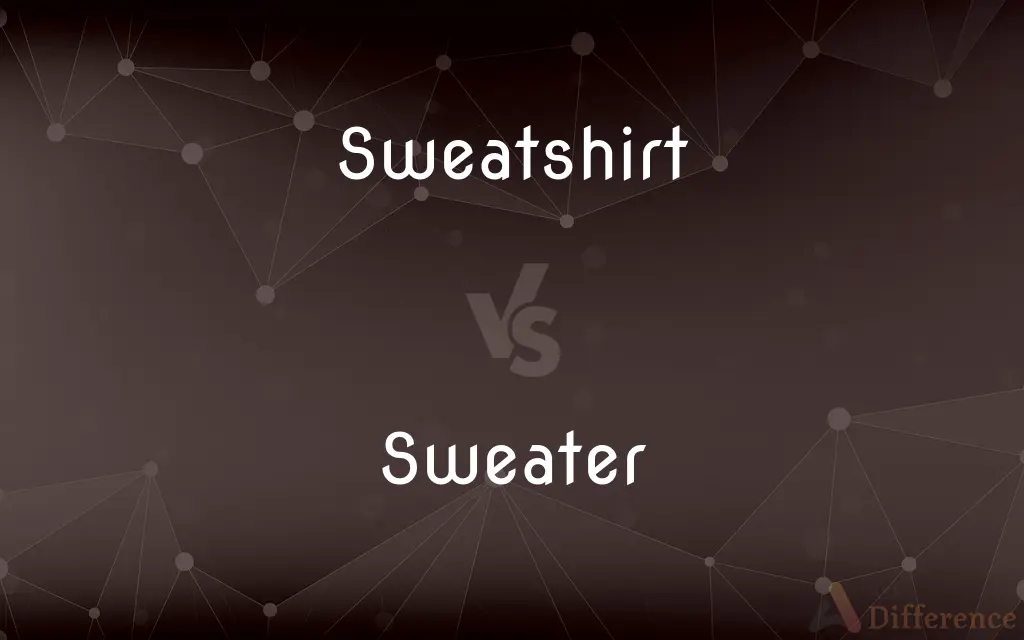Sweatshirt vs. Sweater — What's the Difference?
By Tayyaba Rehman — Updated on October 12, 2023
A "Sweatshirt" is a loose, collarless pullover, typically made from cotton jersey fabric, while a "Sweater" is a knitted garment, typically made from wool or cotton, designed to keep the upper body warm.

Difference Between Sweatshirt and Sweater
Table of Contents
ADVERTISEMENT
Key Differences
A "Sweatshirt" is often recognized for its casual, sporty appeal and is generally made from cotton jersey fabric. On the contrary, a "Sweater" is typically a knitted item, crafted from wool, cotton, or a blend, and might be perceived as a bit more formal or versatile in fashion contexts compared to a sweatshirt.
Within the realm of functionality and utility, sweatshirts often lean towards a comfort and ease, sometimes coming equipped with features like hoods and pockets. Sweaters, however, primarily function as a warmth provider and may present a varied range of styles, from cardigans to turtlenecks, with a diverse application in various attire styles.
In the realm of fabrication, a sweatshirt generally boasts a smooth exterior and a soft, sometimes fleecy interior. Contrastingly, a sweater may exhibit various knits and patterns, presenting a textured surface, which may or may not be designed to be worn over other garments, depending on the style and knit.
Historically, sweatshirts have roots in athletic wear, providing comfort and flexibility to athletes and eventually becoming popular as casual, everyday wear. In contrast, sweaters have their roots in functional and practical wear, often designed for warmth and later evolving into fashion items with varied styles and purposes.
When considering seasonality and wear, sweatshirts, with their straightforward, often unembellished design, align with casual or athletic environments and are commonly used in sporty and laid-back settings. Sweaters find their place in a wider range of settings, from casual to semi-formal, adapting through various styles, patterns, and knits, and might be used in different seasons and occasions compared to sweatshirts.
ADVERTISEMENT
Comparison Chart
Typical Material
Usually made from cotton jersey fabric.
Commonly knitted from wool or cotton.
Formality
Generally considered casual.
Can range from casual to semi-formal.
Origin/Traditional Use
Rooted in athletic wear.
Traditionally designed for warmth.
Design Characteristics
Often has a smooth exterior and soft interior.
Displays various knits and patterns.
Style Variations
Mostly appears as a pullover.
Includes cardigans, pullovers, turtlenecks, etc.
Compare with Definitions
Sweatshirt
A piece of clothing often used for athletic activities.
The team wore matching sweatshirts for the tournament.
Sweater
A warm garment often worn in cooler weather or cold climates.
She packed a sweater for the ski trip to stay warm.
Sweatshirt
An upper-body garment often having long sleeves and a soft interior.
His sweatshirt kept him comfortably warm during the chilly morning.
Sweater
An upper-body garment that may be available in various styles, such as cardigans or pullovers.
Her sweater, a cute cardigan, matched her dress perfectly.
Sweatshirt
A loose, collarless pullover made typically of cotton jersey.
He wore a gray sweatshirt to the gym.
Sweater
A versatile garment that can be crafted in various patterns and knits.
The argyle sweater was a classic addition to his wardrobe.
Sweatshirt
A garment typically worn over a T-shirt and possibly under a coat.
She threw a sweatshirt on over her pajamas to go grab the mail.
Sweater
A sweater or pullover, also called a jumper in British and Australian English, and a windcheater in parts of Australia, is a piece of clothing, typically with long sleeves, made of knitted or crocheted material, that covers the upper part of the body. When sleeveless, the garment is often called a slipover or sweater vest.
Sweatshirt
A casual garment often associated with sports or leisure wear.
She pulled on a sweatshirt before heading out for a run.
Sweater
A garment for the upper body of wool, cotton, or synthetic yarn, typically knitted, having long sleeves, and worn in cold weather.
Sweatshirt
A usually long-sleeved, collarless pullover made traditionally of heavy cotton jersey that is napped on the interior, sometimes having a hood.
Sweater
One that sweats, especially profusely.
Sweatshirt
A zippered jacket of a similar material and design.
Sweater
Something that induces sweating; a sudorific.
Sweatshirt
A loose shirt, usually made of a knit fleece, for athletic wear and now often used as casual apparel.
Sweater
A knitted jacket or jersey, usually of thick wool, worn by athletes before or after exercise.
Sweatshirt
A shirt worn against the skin, usually under other clothing, to absorb sweat.
Sweater
(US) A similar garment worn for warmth.
Sweatshirt
Cotton knit pullover with long sleeves worn during athletic activity
Sweater
One who sweats (produces sweat).
Sweater
One who or that which causes to sweat.
Sweater
A diaphoretic remedy.
Sweater
(historical) An exploitative middleman who subcontracted piece work in the tailoring trade.
Sweater
(archaic) One who sweats coins, i.e. removes small portions by shaking them.
Sweater
A London street ruffian in Queen Anne's time who prodded weak passengers with his sword-point.
Sweater
(transitive) To dress in a sweater.
Sweater
One who sweats.
Sweater
One who, or that which, causes to sweat
Sweater
A crocheted or knitted garment covering the upper part of the body
Sweater
A person who perspires
Sweater
A knitted garment typically made from wool or cotton worn on the upper body.
He chose a chunky knit sweater to wear on the autumn walk.
Sweater
A clothing item often used for layering during the colder months.
He wore a sweater over his shirt to keep warm in the office.
Common Curiosities
What is a basic difference between a sweatshirt and a sweater?
A sweatshirt is typically made of cotton jersey, while a sweater is usually knitted.
Is a sweatshirt considered formal wear?
No, a sweatshirt is generally considered casual wear.
Can a sweater be worn in formal settings?
Yes, certain types of sweaters can be suitable for formal and semi-formal settings.
What is a typical material for sweaters?
Sweaters are commonly made from wool, cotton, or a blend thereof.
What are some common styles of sweaters?
Sweaters can be pullovers, cardigans, turtlenecks, among other styles.
Can a sweatshirt have a hood?
Yes, sweatshirts with hoods are commonly referred to as "hoodies."
Are sweaters universally designed with long sleeves?
While common, sweaters can also be designed with short sleeves or be sleeveless.
Can sweaters have various patterns and textures?
Yes, sweaters can exhibit various patterns, textures, and knitting styles.
Can a sweatshirt be worn for running?
Yes, sweatshirts are often chosen for physical activities like running due to their comfort.
Can a sweatshirt be worn in a professional setting?
Sweatshirts are usually too casual for professional settings, depending on workplace dress codes.
Is a sweatshirt designed for warmth?
Sweatshirts provide warmth but are typically known more for comfort and casual style.
Is a sweater suitable for summer weather?
Sweaters are generally suitable for cooler weather, though lightweight versions may be worn in summer.
Is a sweatshirt typically associated with athletic wear?
Yes, sweatshirts have roots in athletic wear and are often used in sporty contexts.
Do sweatshirts have zippers?
Some sweatshirts have zippers, while traditional ones are pullovers.
Can a sweater be made from synthetic fibers?
Yes, sweaters can be made from a variety of fibers, including synthetic ones.
Share Your Discovery

Previous Comparison
Routing vs. Rooting
Next Comparison
Biennially vs. BiannuallyAuthor Spotlight
Written by
Tayyaba RehmanTayyaba Rehman is a distinguished writer, currently serving as a primary contributor to askdifference.com. As a researcher in semantics and etymology, Tayyaba's passion for the complexity of languages and their distinctions has found a perfect home on the platform. Tayyaba delves into the intricacies of language, distinguishing between commonly confused words and phrases, thereby providing clarity for readers worldwide.














































